There are many cities and towns in Ontario that I feel connected to, primarily through my photography. They have been common in my photography projects, reviews, and videos. One of these cities is Hamilton, Ontario. I spent many years learning the art of photography and exposure by tromping through the many abandoned buildings the city offered to explorers through the early 21st century when I was active in the hobby. While most of my time was spent in either the downtown or industrial sectors, I had only a passing interest in a part of Hamilton, Concession Street, up at the edge of Hamilton Mountain—the rather grand name for the section of the Niagara Escarpment that runs through the city. My first trip to Concession Street was to visit Roger at Camtech to get a service done on my then-new Rolleiflex 2.8F. And while Rodger has since passed away and Camtech has long closed, exploring a small section of the city with a far richer history than I first realised would be nice.

Minolta Maxxum 70 – Minolta Maxxum 50mm 1:1.7 – Arista EDU.Ultra 100 @ ASA-100 – Adox HR-DEV (1+40) 10:15 @ 20C (Constant Rotation)
Like many cities in Ontario, Hamilton grew up in the aftermath of the Anglo-American War of 1812; founded by George Hamilton in the shadow of the Niagara Escarpment, the city found itself surrounded by other towns and villages, both smaller and older than the city itself. One such settlement never gained incorporation as a village but was no less important in the overall history of Ontario. When Lieutenant Governor John Graves Simcoe signed into law an act to reduce (not end) slavery in Upper Canada, the province became a haven for men and women who were formerly enslaved to seek their freedom. Many would find others who had escaped to freedom, while some would settle in larger urban areas; even in Canada, they still faced a great deal of racial discrimination and would go and form communities outside of these established centres. But others in Canada made a point to help these people; William Bridge Green, who owned a large plot up on the Niagara Escarpment, was one such person and began to divide up his lot into smaller town plots and sold or gifted these plots to black families, some freeborn and others formerly enslaved. Soon, a small settlement grew in 1840 along an old animal trail, which would widen to become a dirt road. Today, we know this road as Concession Street, and the settlement grew up between the modern streets of Upper Wellington and Upper Sherman. The community thrived, with farms, shops, and families making a new life in what became known as Little Africa. In 1854, Reverend Joseph P Williams established a 100-seat chapel, an African Episcopal Methodist Church branch. In the 1860s, a Union Church and a school for those escaping slavery opened doors to teach them reading, writing, and math, all things they never had but needed to make a new and better life. The dirt road was paved with stone, and a toll booth was established to pay for the upkeep, so it took the name Stone Road. Little Africa thrived for several decades above Hamilton. Still, as the century moved into the later parts, many began to sell their lands and move elsewhere in Ontario or return to the United States after the American Civil War. As more people moved up to the mountain, access to the city needed to improve. In 1860, James Jolley, who moved to the mountain for his wife’s health, established a footpath from Stone Road at Upper Wellington to John Street South at the base of the mountain. The Jolley Cut, as it quickly became known, would be paved by Jolley in 1873, and the city took over the Jolley Cut, negating the need for a toll. As the century came to a close, the city of Hamilton was encroaching on the small settlement now called Mount Hamilton, and many of the black families were moving elsewhere in Ontario or returning to the United States. Opening in 1893, the Hamilton & Barton Incline Railway connected James Street at the base to Caledonia Road (now Upper James) at the top. The Mount Hamilton Railway, later Wentworth Street Incline Railway, opened in August 1895 and operated a Funicular Railway that connected the city with the mountain; a trip would take 120 seconds. These two railways proved important as by 1900, the mountain boasted a population of 3,000! Stone Road was renamed Concession Street in 1909, and a year later, a massive building boom reshaped the entire mountain. Farms quickly disappeared as smaller house lots and frame homes went up. But as the mountain was not officially part of the city, these areas past Concession lacked access to city water, electricity, and sanitation services. But that didn’t stop many new immigrants from England and Europe from settling on the growing mountain. The First World War interrupted the growth of the area. As the war raged on, the need for more hospitals to support returning soldiers grew. Taking advantage of an overgrown and abandoned farm, the Mount Hamilton Hospital opened in 1916 as a convalescence hospital for returning veterans, and when the war ended, it opened to the general public. During the interwar period, calls to have the city annex Mount Hamilton grew. Many in the area saw the lack of services was hindering growth, that there was a lack of water and sewage, and that basic services like police and fire protection were hindering the growth of the area. The city, however, was less interested, citing the increased cost of bringing these services up the mountain. After some negotiations in 1929, Mount Hamilton became a part of the City of Hamilton. The Depression did take its toll, with both incline railways closing in the 1930s. In the post-war era, the area grew even faster as many embraced the new economic boom of the mid-century. The Mount Hamilton Hospital took on a new name in 1954, named for Nora-Francis Henderson, a promoter of women’s and children’s health, along with being the first women city controller and long-time councillor and supporter of the mountain community. As the community grew, the city built a set of stairs at the site of the former Wentworth Incline Railway, parks sprung up along the mountain brow, and today, the area around Concession Street remains a vibrant and active community. With shops and restaurants and beautiful views of the lower city. While many old buildings have disappeared, plenty of early 20th-century surviving structures remain. Henderson Hospital took the name Juravinski in 2010 and was transformed into a state-of-the-art cancer treatment centre 2010; you can still find the original hospital building if you know where to look. Best of all, the density is still low in the area, which helps keep the charm and feel of the area from the 20th century.

Minolta Maxxum 70 – Minolta Maxxum 50mm 1:1.7 – Arista EDU.Ultra 100 @ ASA-100 – Adox HR-DEV (1+40) 10:15 @ 20C (Constant Rotation)
Minolta Maxxum 70 – Minolta Maxxum 50mm 1:1.7 – Arista EDU.Ultra 100 @ ASA-100 – Adox HR-DEV (1+40) 10:15 @ 20C (Constant Rotation)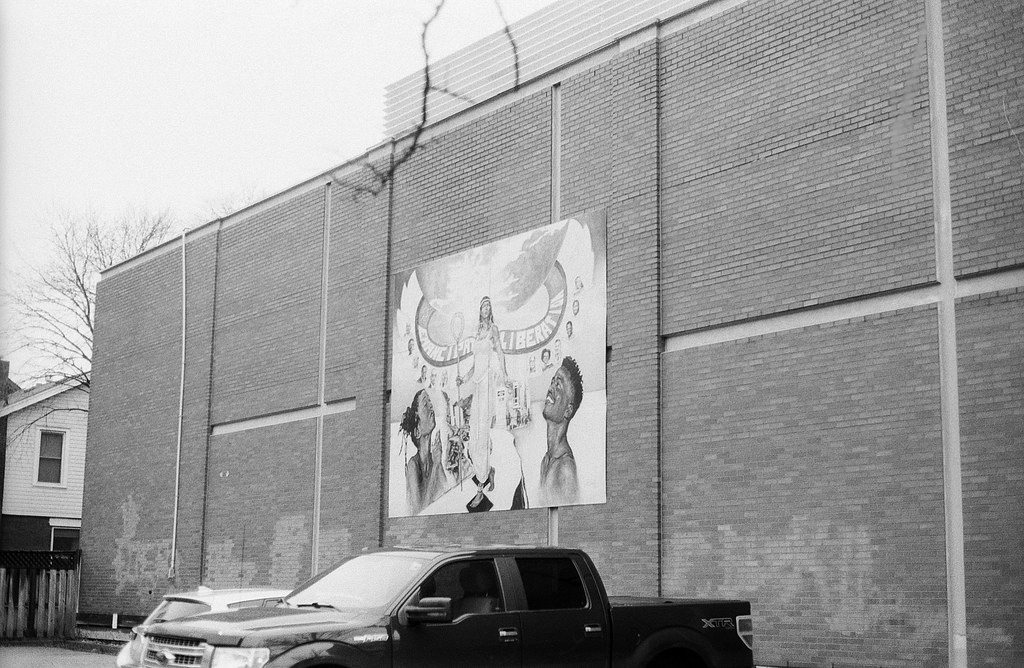
Minolta Maxxum 70 – Minolta Maxxum 50mm 1:1.7 – Arista EDU.Ultra 100 @ ASA-100 – Adox HR-DEV (1+40) 10:15 @ 20C (Constant Rotation)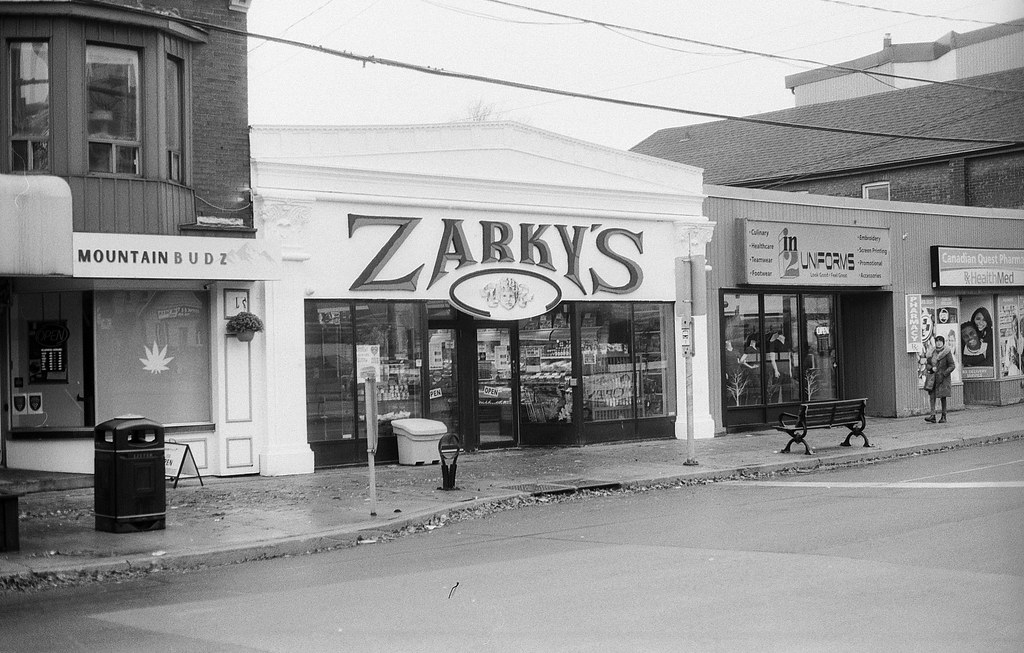
Minolta Maxxum 70 – Minolta Maxxum 50mm 1:1.7 – Arista EDU.Ultra 100 @ ASA-100 – Adox HR-DEV (1+40) 10:15 @ 20C (Constant Rotation)
The whole time I was out it felt like Silent Hill, there were a few people out braving the elements, but not many. The one thing I was glad to have done is that I had already written a narrative on the history of the area, which made it both easy and difficult to choose the images. I ended up being a little too conservative on choosing my shots and also did not realise how little distance I had to walk. I think having the 50mm lens did limit my vision, but I was also smart to bring it along for the ride. While I did make sure to get some shots off the escarpment, I did make a point to focus on the street and surrounding areas. The route I took was circular, parking a little bit past Juravinski, I walked across to Sam Lawrence Park, cutting down to get a shot of the Jolley Cut (a far cry from the original 1860 path), before walking back along the mountain brow itself. From there I photographed what I saw and caught my eye, I of course included the former location of Camtech, now a financial services office, the library (where the Union Church and Mission School once sat) has a lovely plaque outlining the area’s history with the black community and a mural regarding emancipation in the British Empire and Canada. Juravinski of course got some images also, I made sure to capture the historic sections and found a neat memorial plaque near a side entrance.

Minolta Maxxum 70 – Minolta Maxxum 50mm 1:1.7 – Arista EDU.Ultra 100 @ ASA-100 – Adox HR-DEV (1+40) 10:15 @ 20C (Constant Rotation)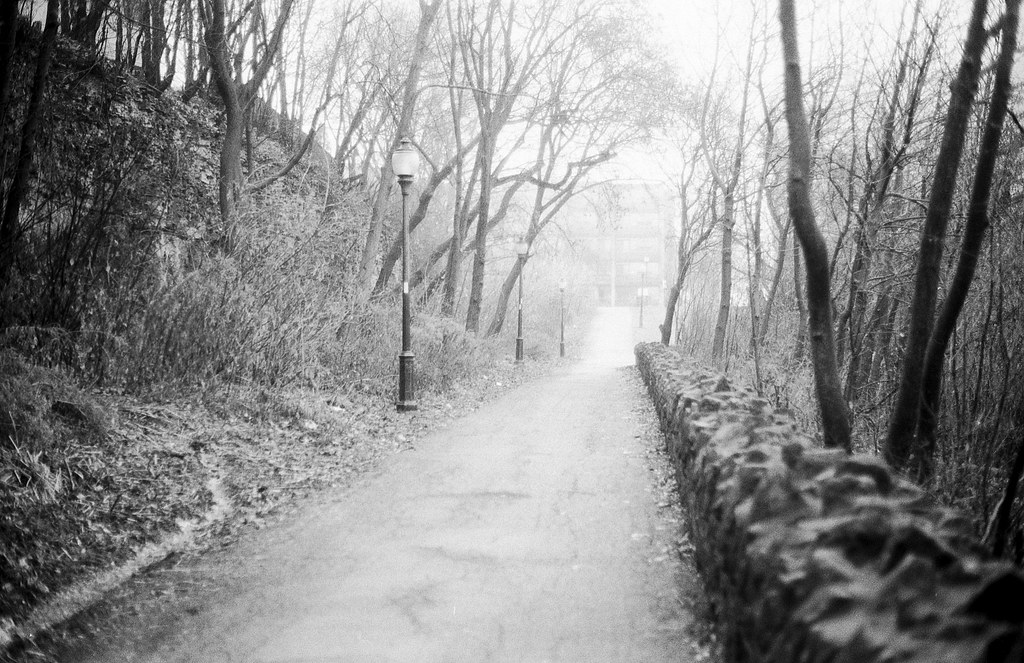
Minolta Maxxum 70 – Minolta Maxxum 50mm 1:1.7 – Arista EDU.Ultra 100 @ ASA-100 – Adox HR-DEV (1+40) 10:15 @ 20C (Constant Rotation)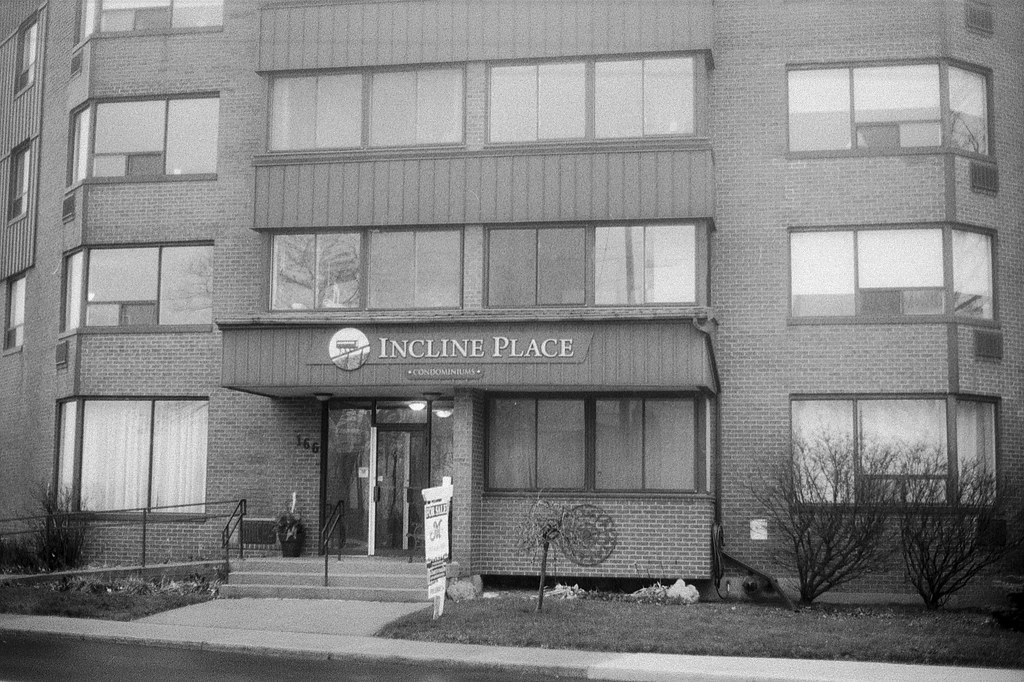
Minolta Maxxum 70 – Minolta Maxxum 50mm 1:1.7 – Arista EDU.Ultra 100 @ ASA-100 – Adox HR-DEV (1+40) 10:15 @ 20C (Constant Rotation)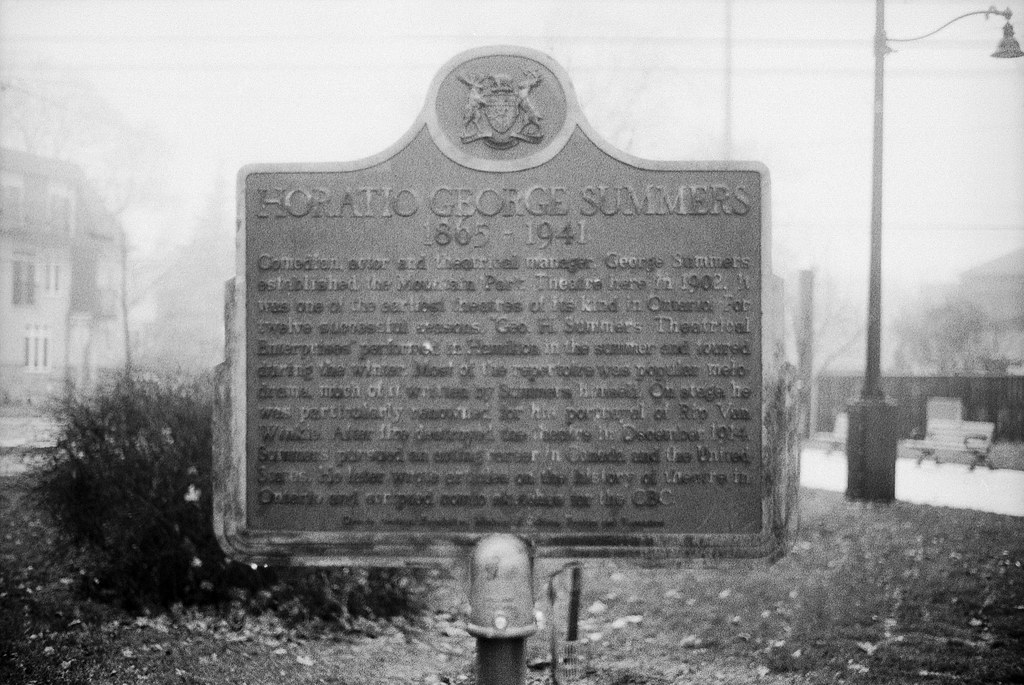
Minolta Maxxum 70 – Minolta Maxxum 50mm 1:1.7 – Arista EDU.Ultra 100 @ ASA-100 – Adox HR-DEV (1+40) 10:15 @ 20C (Constant Rotation)
In an interesting twist, the day’s weather was less than ideal. It’s only fair that the last day out for the 2023 Frugal Film Project looked a lot like the first day out for the project. Dull, dark, drizzly and ugly. And wanting to shoot the film at box speed, I made the choice to swap out the 28-100mm lens with the trusty 50mm f/1.7 for this final roll. There were some reasons for this, I shoot a wide angle lens most of the time, so a change of view is good. And while it doesn’t always suit this situation, I needed to get something faster than the kit lens, so I could still shoot the roll at the box speed of ASA-100. For the developer I went with Adox HR-DEV, this developer is designed for Adox HR-50, but in my review of the developer I found that it works well with multiple other film stocks, including non-Adox stocks. When I reviewed the developer, it did a superb job with both Fomapan 200 and Fomapan 400, so I wanted to complete the circle and use it with Arista 100. Personally, these aren’t my favourite when it comes to quality. In many cases there is an exaggeration in the grain, and I had to do a lot of work in post-processing to get the images back (which may also not have helped with the quality). But you always keep going and lean into the whole environment. Another thirty-second reduction in the development times to better compensate for constant rotation might have helped, the negatives were dense when I pulled them out of the tank, now the fog and mist in the air could also be a factor in this case.
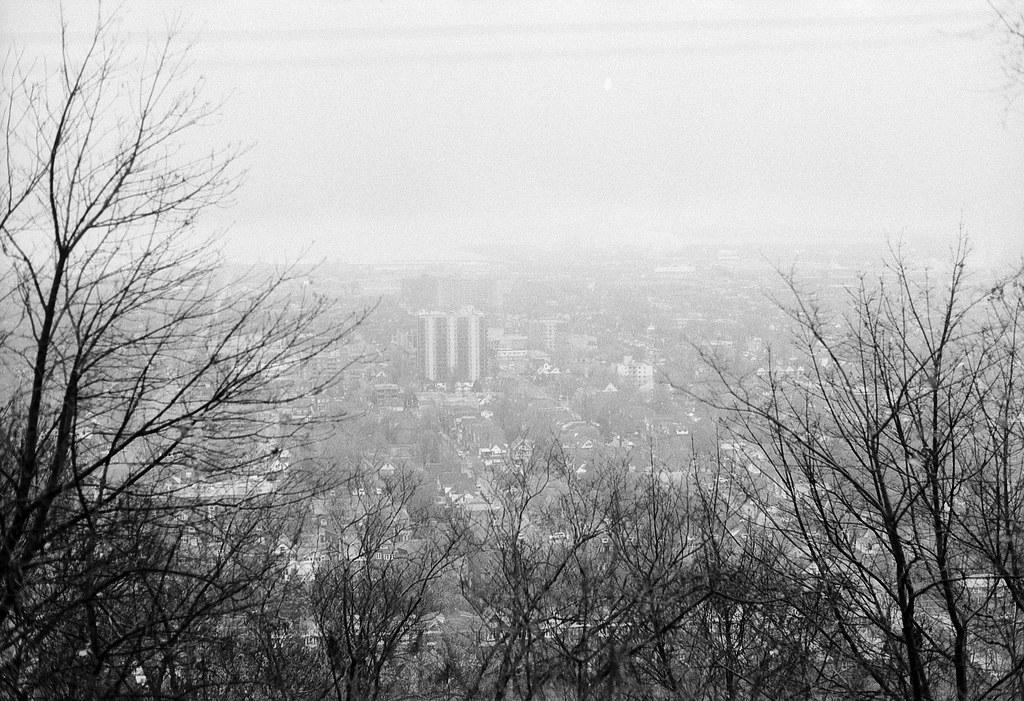
Minolta Maxxum 70 – Minolta Maxxum 50mm 1:1.7 – Arista EDU.Ultra 100 @ ASA-100 – Adox HR-DEV (1+40) 10:15 @ 20C (Constant Rotation)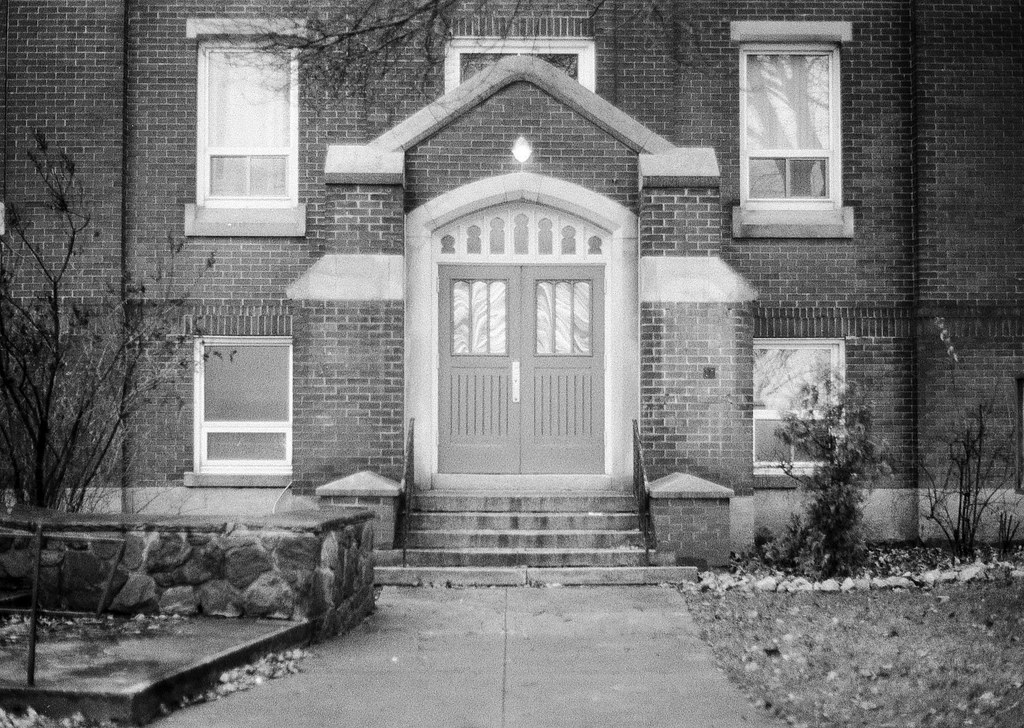
Minolta Maxxum 70 – Minolta Maxxum 50mm 1:1.7 – Arista EDU.Ultra 100 @ ASA-100 – Adox HR-DEV (1+40) 10:15 @ 20C (Constant Rotation)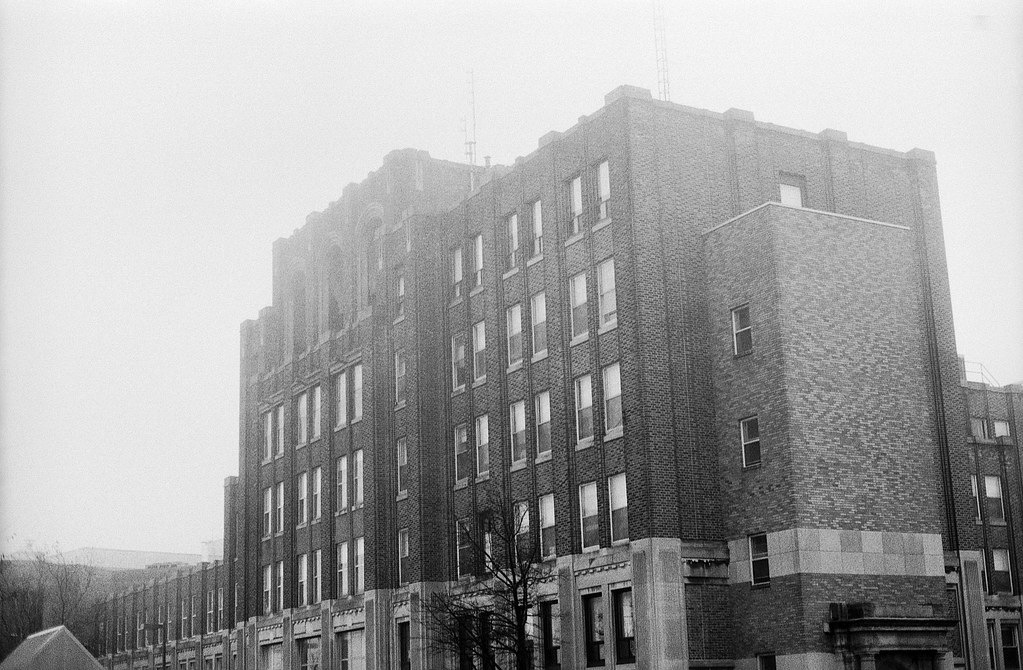
Minolta Maxxum 70 – Minolta Maxxum 50mm 1:1.7 – Arista EDU.Ultra 100 @ ASA-100 – Adox HR-DEV (1+40) 10:15 @ 20C (Constant Rotation)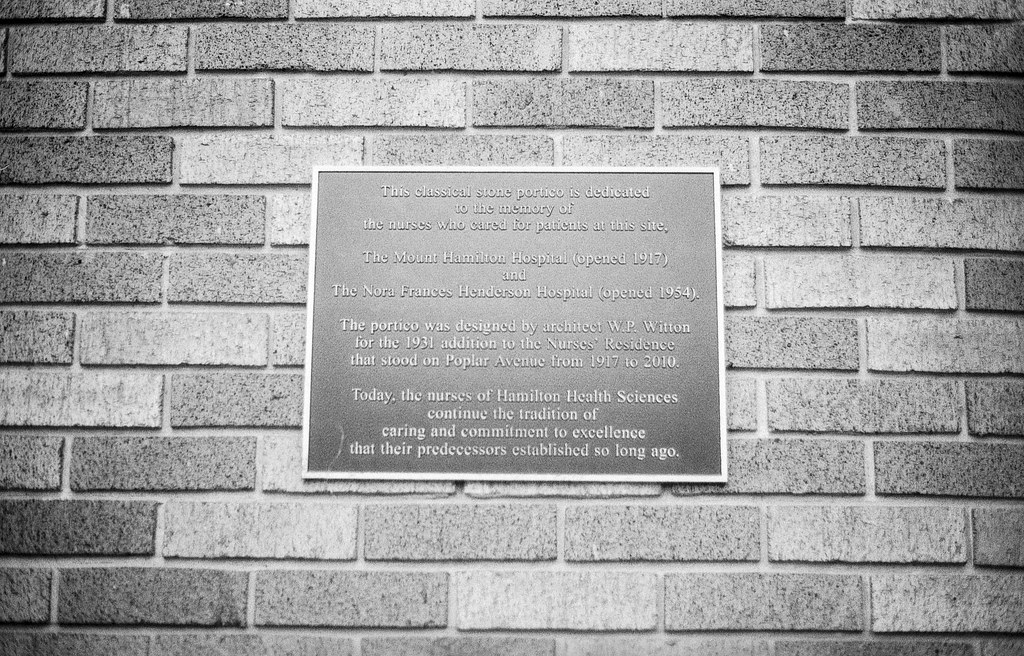
Minolta Maxxum 70 – Minolta Maxxum 50mm 1:1.7 – Arista EDU.Ultra 100 @ ASA-100 – Adox HR-DEV (1+40) 10:15 @ 20C (Constant Rotation)
And that wraps it up for 2023. I had a lot of fun in this year’s edition of the Frugal Film Project, and I certainly plan on continuing for 2024; I already have my camera and film picked up and waiting for action. In January, I’ll post my favourite twelve images from this year and introduce what I’ll be shooting within 2024. I’ve also been putting the final touches on a ‘zine that features all the images I used in these blog posts and a compressed entry for each month. It will be available in early January through my Blurb store. You can also see all the images I shot this year over on Flickr! Next month, we are checking out the original capital of Ontario back before it was even Ontario. We’re heading off to kick off the new year in Niagara-On-The-Lake!
Enjoyed the photography and history! Have a Merry Christmas and a Happy New Year!
interesting as always Alex. whats your camera of choice for next year going to be? thanks for all fab pictures this have a fab christmas.
Thanks! My camera for next year is a Canon EOS 3000! Happy Christmas!